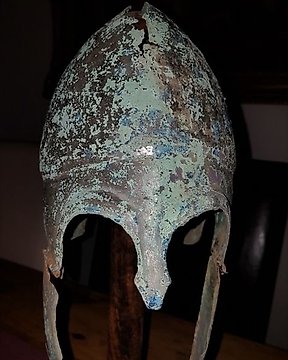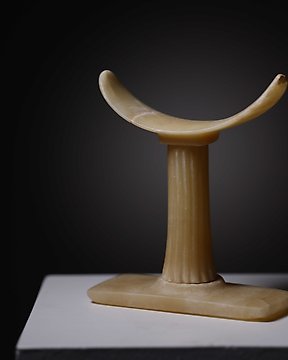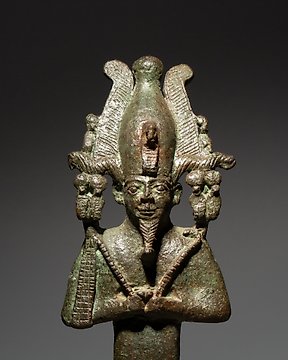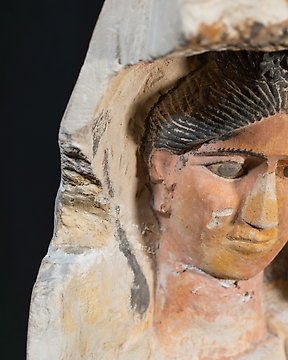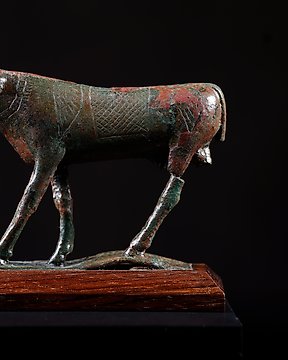
Ancient Egyptian Bronze Egyptian Apis God With Spanish export license - 7 cm
Catawiki is continuously updating its technology. You are currently using an outdated browser. To optimise your browsing experience, please update your browser.
You can set your cookie preferences using the toggles below. You can update your preferences, withdraw your consent at any time, and see a detailed description of the types of cookies we and our partners use in our Cookie Policy.
No. 83891113

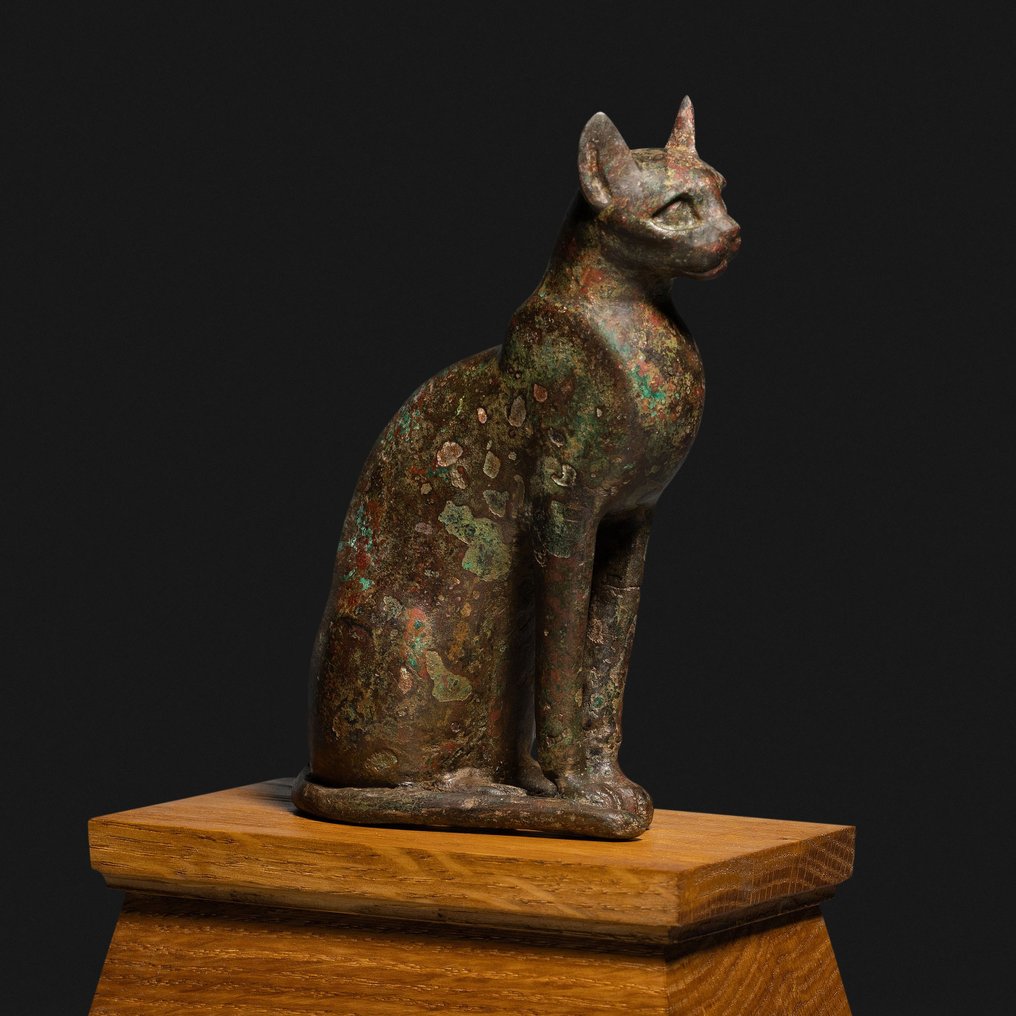
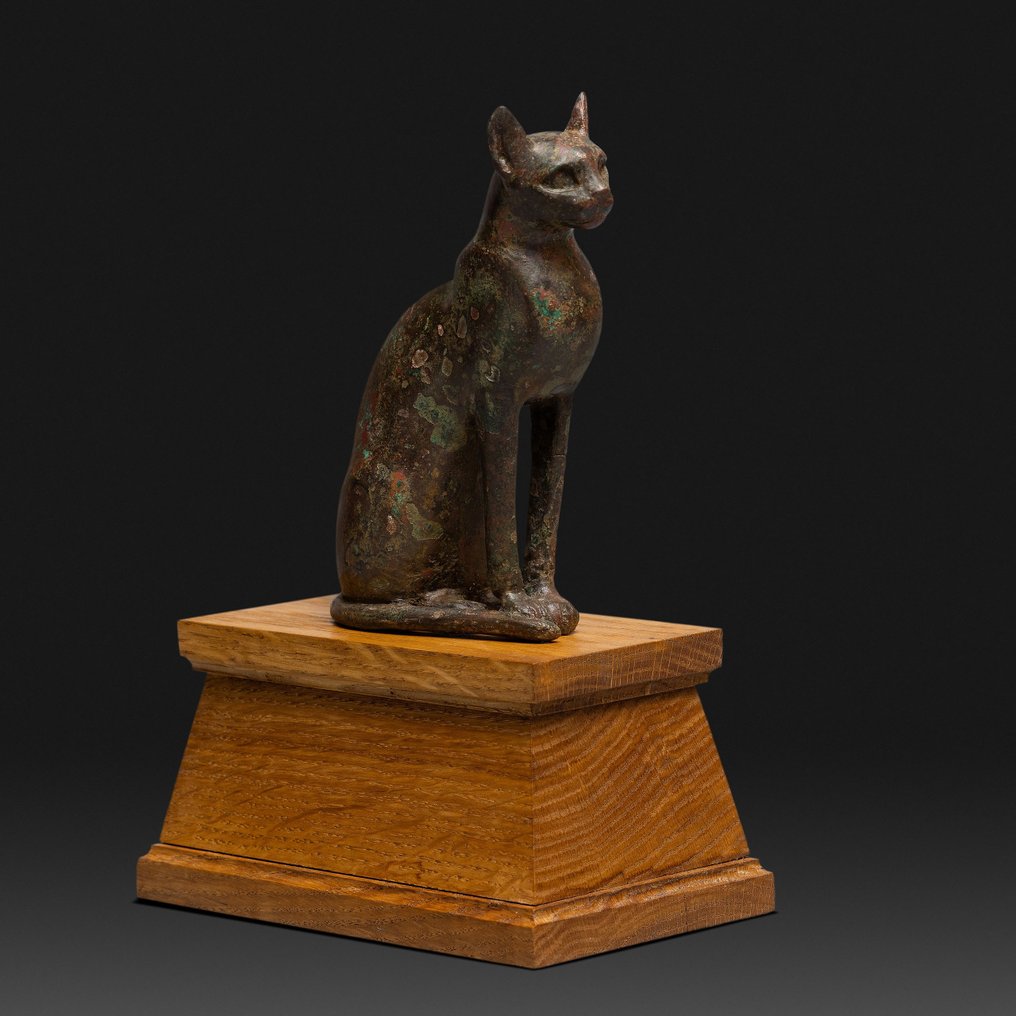
SCULPTURE OF THE GODDESS BASTET
- the most fine style-
- NICE EXAMPLE -
- THERMOLUMINISCENSE TEST (done inside the cat, on the remains of the core of the casting of the sculpture with the lost wax technique)-
Ancient Egypt, Late Period, 664 – 332 BC
Material: Bronze.
Dimensions: Height 15.2 cm without stand.
PROVENANCE: Private collection, Switzerland. Acquired at Galerie Nefer on July 30, 1980.
CONDITION: Good state of conservation, without restorations.
DOCUMENTS:
-Attached purchase invoice at Galerie Nefer, dated July 30, 1980. (copy for the buyer)
- Thermoluminescence test attached.
DESCRIPTION:
Slender and elegant votive sculpture of the goddess Bastet, made in hollow bronze with the lost wax technique, represented in her animal form: a domestic cat. The feline is represented sitting, leaning on its hindquarters, with its front legs erect, and its head raised, looking forward. Its ears are pointed upwards and its tail surrounds the right thigh forward. It shows an expectant position, while monitoring what is happening around it. This is its classic representation in Egyptian art.
The main characteristic of this sculpture is the finesse in its facial features. In both ears you can see a small circular hole to include a pair of earrings, usually gold hoops, now lost. The best example in bronze is the well-known Bastet of the British Museum (Fig. 1). A detail to highlight is the depth of the eyes, it is most likely due to the fact that in ancient times they were decorated with stone inlays or precious materials such as gold or silver, to give the animal a more realistic appearance.
The animal would be placed on a flat rectangular base, normally made of the same material, although it could also have been made of wood. At the bottom of the figure you can see two pointed bronze spikes or terminals, to insert it into the base and thus allow it to be held.
Bastet is a goddess from Egyptian mythology who is identified with the figure of cats. It is often represented with the body of a woman and the head of a cat (Fig. 2), or simply as a very stylized full-length cat. The mission of this goddess is diffuse, some think that she symbolized home, joy, harmony and happiness. Others speculate that it was a deity in charge of symbolizing sexual desire, the moon, fertility, motherhood or feminine virtues in general.
The goddess had as her sister the very dangerous goddess Sejmet (Fig. 3), who was also represented by another feline, the enraged lioness. A goddess who represented the malefic qualities of the sun. Although Bastet was an apparently peaceful goddess, if she got angry she could be much more angry than her sister, therefore it was advisable to keep her pleased.
Her representation as a cat is not coincidental, and the nature of the cat, or rather of the cats, is that of an animal of great fertility, and a protective mother with all her puppies, in addition to being nocturnal animals that feel comfortable with darkness to hunt.
In the cult of the goddess, the priests chose a cat, which was worshiped and venerated, treating it as the very incarnation of the goddess. Every year, when spring approached, its faithful celebrated the Festival of Drunkenness. In this festival, processions took place with images of the goddess that were transported in a large boat throughout the Nile. When the procession arrived at Bubastis (a city consecrated to the goddess), a real party full of drink began in which everyone ended up harmed by alcohol and dances. The only intention was to worship the goddess so that Bastet would calm down and not take out her sharp nails.
Her cult was so important that cats, the representation and incarnation of the goddess, were raised in her temples, and upon their death, they were carefully mummified, burying them in specific tombs for them (Fig. 4). Necropolises of this type have been found in Bubastis, Saqqara, Tanis, Beni Hassan and Thebes.
This piece has been made using the lost wax technique, a sculptural procedure by which a mold is first made from a prototype, traditionally carved in beeswax. The previous model is surrounded by a thick layer of soft material that solidifies, usually mud. Once hardened, it is placed inside an oven, which melts the wax figure, leaving it through specially created holes, and in its place molten metal is injected that takes the exact shape of the model. To extract the final piece it is necessary to remove the mold.
BIBLIOGRAPHY:
‒ BLEIBERG, E. Soulful Creatures: Animal Mummies in Ancient Egypt. Brooklyn Museum. 2013.
‒ HOULIHAN, P. The Animal World of the Pharaohs. Thames and Hudson. Londres. 1996.
‒ MALEK, J. The Cat in Ancient Egypt. University of Pennsylvania Press. 1997.
PARALLELS:
Fig. 1 Goddess Bastet. Bronze, silver and gold. Ancient Egypt. Late Period, 664 – 323 BC. C. 42 cm high. From Saqqara. British Museum, London. Inv. EA25565.
Fig. 2 Goddess Bastet. Bronze. Ancient Egypt. Late Period, 664 – 323 BC. C. 27 cm high. British Museum, London. Inv. EA64391.
Fig. 3 Statue of the goddess Sekhmet. Granodiorite. Ancient Egypt. New Kingdom, 18th Dynasty, Reign of Amenhotep III, c. 1,390 – 1,352 BC. C. 210 cm high. From Karnak. Metropolitan Museum of Art, New York. Inv.15.8.2.
Fig. 4 Cat mummies. Ancient Egypt. Roman period, 30 BC C. – 1st century AD. C. 45. 55 cm high. British Museum, London. Inv. EA25565.
Notes:
Shipping: DHL Express with insurance or Door-to-door transportation of specialized art.
This lot is Guaranteed to be Authentic and Genuine and will include a Certificate of Authenticity.
The seller can prove that the lot was obtained legally, provenance statement seen by Catawiki.
Important information. The seller guarantees that he is entitled to sell/export this lot.
The seller will take care that any necessary permits, like an export license will be arranged.
The seller will inform the buyer about the status of it if this takes more than a few days.
#masterpieces
SCULPTURE OF THE GODDESS BASTET
- the most fine style-
- NICE EXAMPLE -
- THERMOLUMINISCENSE TEST (done inside the cat, on the remains of the core of the casting of the sculpture with the lost wax technique)-
Ancient Egypt, Late Period, 664 – 332 BC
Material: Bronze.
Dimensions: Height 15.2 cm without stand.
PROVENANCE: Private collection, Switzerland. Acquired at Galerie Nefer on July 30, 1980.
CONDITION: Good state of conservation, without restorations.
DOCUMENTS:
-Attached purchase invoice at Galerie Nefer, dated July 30, 1980. (copy for the buyer)
- Thermoluminescence test attached.
DESCRIPTION:
Slender and elegant votive sculpture of the goddess Bastet, made in hollow bronze with the lost wax technique, represented in her animal form: a domestic cat. The feline is represented sitting, leaning on its hindquarters, with its front legs erect, and its head raised, looking forward. Its ears are pointed upwards and its tail surrounds the right thigh forward. It shows an expectant position, while monitoring what is happening around it. This is its classic representation in Egyptian art.
The main characteristic of this sculpture is the finesse in its facial features. In both ears you can see a small circular hole to include a pair of earrings, usually gold hoops, now lost. The best example in bronze is the well-known Bastet of the British Museum (Fig. 1). A detail to highlight is the depth of the eyes, it is most likely due to the fact that in ancient times they were decorated with stone inlays or precious materials such as gold or silver, to give the animal a more realistic appearance.
The animal would be placed on a flat rectangular base, normally made of the same material, although it could also have been made of wood. At the bottom of the figure you can see two pointed bronze spikes or terminals, to insert it into the base and thus allow it to be held.
Bastet is a goddess from Egyptian mythology who is identified with the figure of cats. It is often represented with the body of a woman and the head of a cat (Fig. 2), or simply as a very stylized full-length cat. The mission of this goddess is diffuse, some think that she symbolized home, joy, harmony and happiness. Others speculate that it was a deity in charge of symbolizing sexual desire, the moon, fertility, motherhood or feminine virtues in general.
The goddess had as her sister the very dangerous goddess Sejmet (Fig. 3), who was also represented by another feline, the enraged lioness. A goddess who represented the malefic qualities of the sun. Although Bastet was an apparently peaceful goddess, if she got angry she could be much more angry than her sister, therefore it was advisable to keep her pleased.
Her representation as a cat is not coincidental, and the nature of the cat, or rather of the cats, is that of an animal of great fertility, and a protective mother with all her puppies, in addition to being nocturnal animals that feel comfortable with darkness to hunt.
In the cult of the goddess, the priests chose a cat, which was worshiped and venerated, treating it as the very incarnation of the goddess. Every year, when spring approached, its faithful celebrated the Festival of Drunkenness. In this festival, processions took place with images of the goddess that were transported in a large boat throughout the Nile. When the procession arrived at Bubastis (a city consecrated to the goddess), a real party full of drink began in which everyone ended up harmed by alcohol and dances. The only intention was to worship the goddess so that Bastet would calm down and not take out her sharp nails.
Her cult was so important that cats, the representation and incarnation of the goddess, were raised in her temples, and upon their death, they were carefully mummified, burying them in specific tombs for them (Fig. 4). Necropolises of this type have been found in Bubastis, Saqqara, Tanis, Beni Hassan and Thebes.
This piece has been made using the lost wax technique, a sculptural procedure by which a mold is first made from a prototype, traditionally carved in beeswax. The previous model is surrounded by a thick layer of soft material that solidifies, usually mud. Once hardened, it is placed inside an oven, which melts the wax figure, leaving it through specially created holes, and in its place molten metal is injected that takes the exact shape of the model. To extract the final piece it is necessary to remove the mold.
BIBLIOGRAPHY:
‒ BLEIBERG, E. Soulful Creatures: Animal Mummies in Ancient Egypt. Brooklyn Museum. 2013.
‒ HOULIHAN, P. The Animal World of the Pharaohs. Thames and Hudson. Londres. 1996.
‒ MALEK, J. The Cat in Ancient Egypt. University of Pennsylvania Press. 1997.
PARALLELS:
Fig. 1 Goddess Bastet. Bronze, silver and gold. Ancient Egypt. Late Period, 664 – 323 BC. C. 42 cm high. From Saqqara. British Museum, London. Inv. EA25565.
Fig. 2 Goddess Bastet. Bronze. Ancient Egypt. Late Period, 664 – 323 BC. C. 27 cm high. British Museum, London. Inv. EA64391.
Fig. 3 Statue of the goddess Sekhmet. Granodiorite. Ancient Egypt. New Kingdom, 18th Dynasty, Reign of Amenhotep III, c. 1,390 – 1,352 BC. C. 210 cm high. From Karnak. Metropolitan Museum of Art, New York. Inv.15.8.2.
Fig. 4 Cat mummies. Ancient Egypt. Roman period, 30 BC C. – 1st century AD. C. 45. 55 cm high. British Museum, London. Inv. EA25565.
Notes:
Shipping: DHL Express with insurance or Door-to-door transportation of specialized art.
This lot is Guaranteed to be Authentic and Genuine and will include a Certificate of Authenticity.
The seller can prove that the lot was obtained legally, provenance statement seen by Catawiki.
Important information. The seller guarantees that he is entitled to sell/export this lot.
The seller will take care that any necessary permits, like an export license will be arranged.
The seller will inform the buyer about the status of it if this takes more than a few days.
#masterpieces


